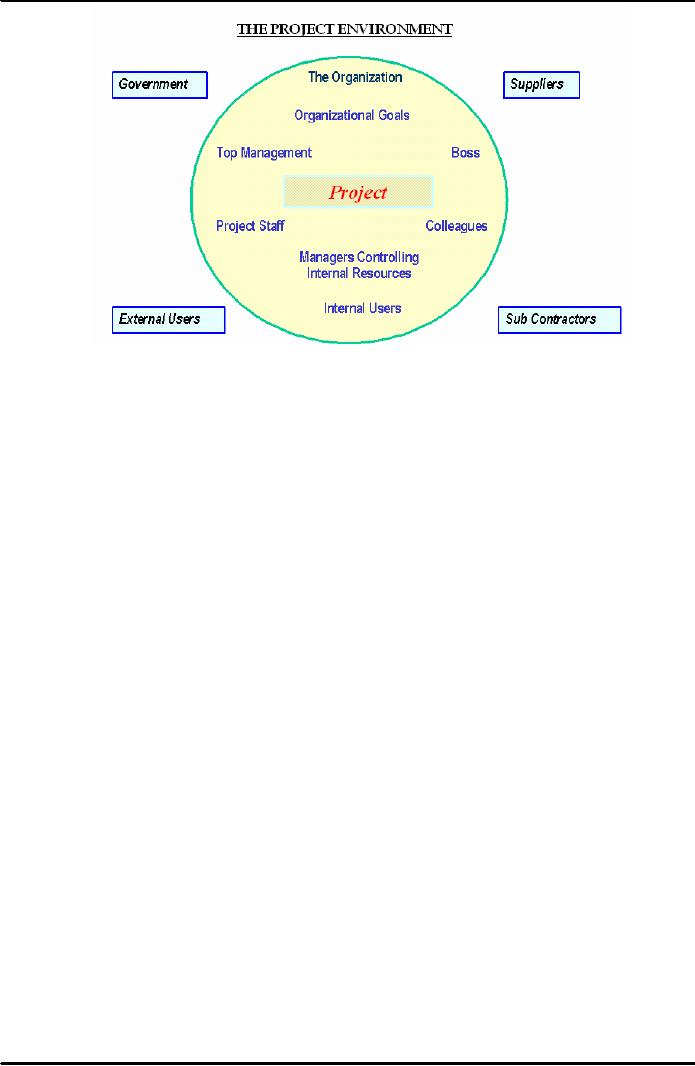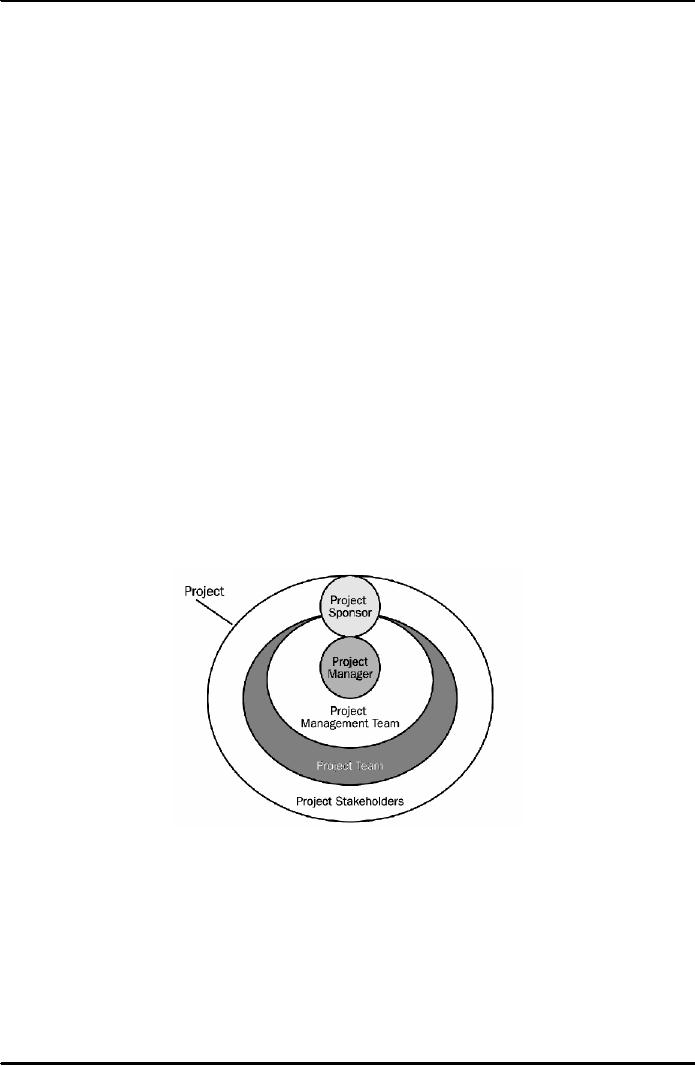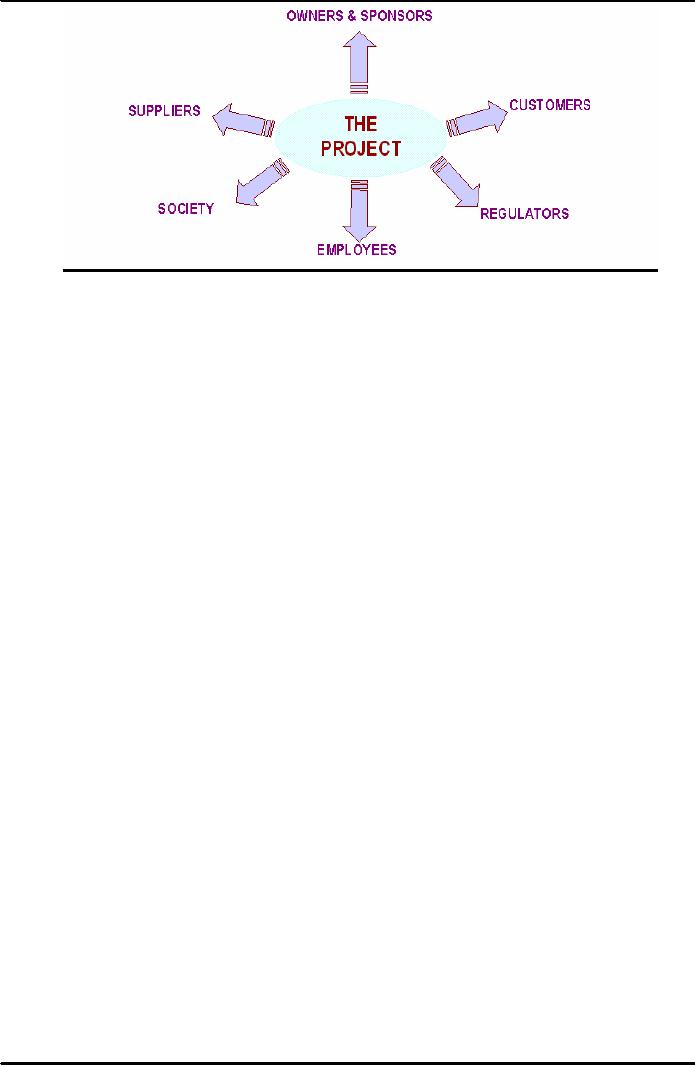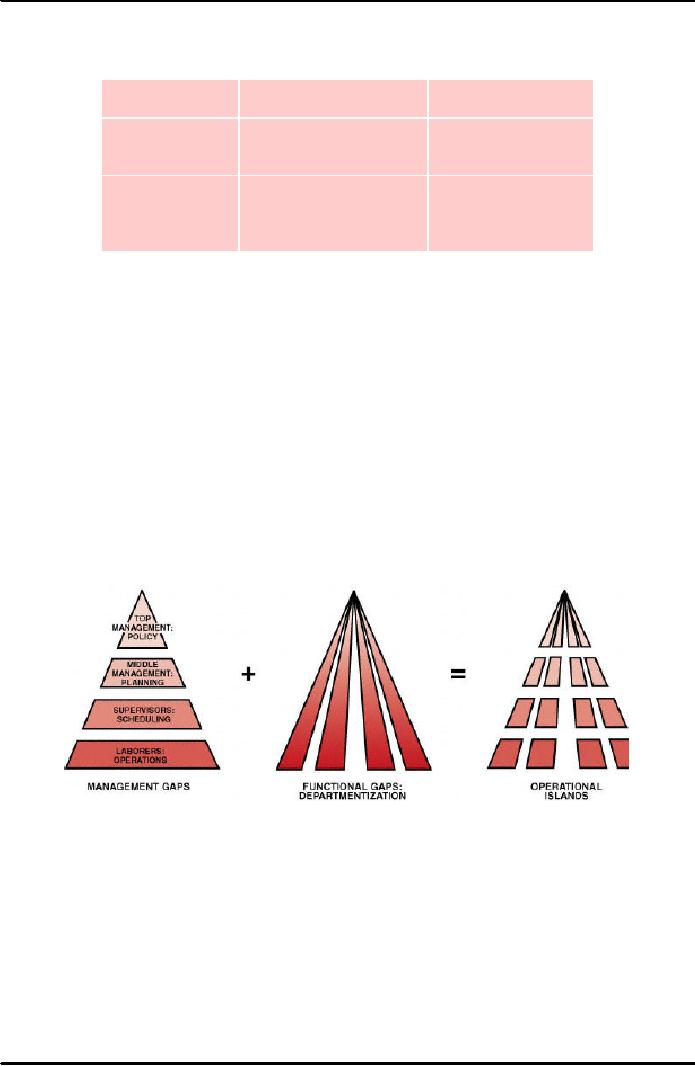 |

Project
Management MGMT627
VU
LESSON
02
CONCEPTS,
DEFINITIONS AND NATURE OF
PROJECTS
Broad
Contents
What
is a project?
Why
projects?
Attributes
of a project
Characteristics
of projects
Project
environment
Project
participants
Projects
and strategic planning
Examples
of projects
Project
types
2.1
What
is a Project?
J.
M. Juran defined that "a
project is a problem scheduled
for solution." Problem
refers to the
gap
between where you are and where
you want to be, with an
obstacle that prevents
easy
movement
to close the gap.
Projects
are a group of activities
that have to be performed with
limited resources to
yield
specific
objectives, in a specific time, and in a
specific locality. Thus, a
project is a temporary
endeavour
employed to create a unique product,
service or results. Projects
are an
investment
on which resources are used
to create assets that will
produce benefits over an
expanded
period of time. It is a unique
process, consisting of a set of
coordinated and controlled
activities
with start and finish dates,
undertaken to achieve an objective
conforming to specific
requirements,
including the constraints of time,
cost and
resources.
2.1.1
Short
Range Projects:
They
are completed within one year, and
are focused towards achieving the
tactical
objectives.
They are less rigorous;
require less or no risk.
They are not cross
functional.
These
projects require limited Project
Management tools, and have
low level of
sophistication.
It is easy to obtain approval,
funding and organizational support
for short
range
projects. For example, reduce defect in
shop number two from 6 to 4
percent.
2.1.2
Long
Range Projects:
These
projects involve higher risk
and a proper feasibility analysis is
essential before
starting
such projects. They are most
often cross functional.
Their major impact is
over
long
period of time, on internal as
well as external organization.
Large numbers of
resources
are required to undertake
long range projects and they
require breakthrough
initiatives
from the members.
2.2
Why
Projects are initiated?
Projects
are initiated in the following
scenarios:
�
When
starting a new
business.
�
In
order to develop/ modify a
product or service.
�
For
relocating and/or closing a
facility.
�
For
regulatory mandate.
�
For
some community
issues.
�
In
order to re-engineer the process so as to
reduce complaints, reduce
cycle time, and
eliminate
errors.
�
For
implementing a new system or
process.
�
To
introduce new equipment,
tools or techniques.
7

Project
Management MGMT627
VU
2.3
Attributes
of a Project:
Projects
focus on a single goal as compared to a
program. They have customers
who are
affected
by the end results. They have to be
completed within specified time
frame (completion
date),
within budget (limited
resources including, people,
money, machines) and should
be
according
to the specifications (with a certain
level of functionality and
quality).
In
brief projects are:
�
Directed
towards achieving a specific
result.
�
Coordination
of undertaking of interrelated
activities.
�
Of
limited duration, a beginning and an
end.
�
Prone
to risks, that is, every project
has a certain amount of
risk.
2.4
Characteristics
of Projects:
�
As
already mentioned projects are
temporary with a definite
beginning and a definite end.
�
They
also have temporary opportunities and
temporary teams.
�
Projects
are terminated when the
objectives are achieved, or conversely,
if the objectives
cannot
be met.
�
Most
of the projects last for several years.
However, they have a finite
duration.
�
They
involve multiple resources (human and
non-human) and require close
coordination.
�
They
are composed of interdependent
activities.
�
At
the end of the project, a unique product,
service or result is created. Some
degree of
customization
is also a characteristic of projects.
�
Projects
encompass complex activities
that are not simple,
and may require repetitive
acts.
�
They
also include some connected
activities. Some order and
sequence is required in
project
activities.
The output from one activity
is an input to another.
�
Project
Management lives in the world of
conflict. The management has
to compete with
functional
departments for "resources and
personnel".
�
There
exists a constant conflict for
project resources and for
leadership roles in solving
project
problems.
�
In
every project, clients want
changes, and the parent organization aims
at maximization of
profits.
�
There
can be two bosses at a time
and that too with
different priorities and
objectives.
2.5
Project
Environment:
All
projects are planned and implemented in a
social, economic, environmental,
political and
international
context.
�
Cultural
and Social Environment
is
that how a project affects the
people and how they
affect
the project. This requires understanding
of economic, demographic, ethical,
ethnic,
religious
and cultural sensitivity
issues.
�
International
and Political Environment refers to the
knowledge of international,
national,
regional
or local laws and customs, time
zone differences, teleconferencing
facilities, level
of
use of technology, national
holidays, travel means and
logistic requirements.
�
Physical
Environment is the
knowledge about local
ecology and physical geography
that
could
affect the project, or be affected by the
project.
8

Project
Management MGMT627
VU
Figure
2.1: Project
Environment
2.6
Project
Participants:
2.6.1
Stakeholders:
Stakeholders
are the ones who have a
share, or an interest in an enterprise.
Stakeholders
in
a company may include shareholders,
directors, management, suppliers,
government,
employees,
customers, and the
community.
Stakeholders
are influenced by the
outcomes
and objectives. They have varying
level of responsibility and authority.
Thus,
they
should not be ignored. A
project manager should try
to manage and fulfill the
expectations
of the stakeholders. There are both
positive and negative stakeholders.
In
some
cases, stake holder's roles
and responsibilities are
overlapping. For example,
an
engineering
firm also provides
financing.
Project
stakeholders are individuals and
organizations that are
actively involved in the
project,
or whose interests may be
affected as a result of project
execution or project
completion.
They may also exert
influence over the project's
objectives and outcomes.
The
project management team must
identify the stakeholders, determine
their
requirements
and expectations, and, to the extent possible, manage
their influence in
relation
to the requirements to ensure a successful
project.
As
already mentioned, stakeholders have
varying levels of responsibility and
authority
when
participating on a project and these
can change over the course
of the project's
life
cycle. Their responsibility and
authority range from occasional
contributions in
surveys
and focus groups to full project sponsorship,
which includes providing
financial
and
political support. Stakeholders who
ignore this responsibility
can have a damaging
impact
on the project objectives. Likewise,
project managers who ignore
stakeholders
can
expect a damaging impact on project
outcomes.
Sometimes,
stakeholder identification can be
difficult. For example, some
would argue
that
an assembly-line worker, whose
future employment depends on the outcome
of a
new
product-design project, is a stakeholder.
Failure to identify a key stakeholder
can
cause
major problems for a
project.
9

Project
Management MGMT627
VU
Stakeholders
may have a positive or negative
influence on a project.
Positive
stakeholders
are those who would
normally benefit from a
successful outcome from the
project,
while negative stakeholders are
those who see negative
outcomes from the
project's
success. For example,
business leaders from a
community that will
benefit
from
an industrial expansion project
may be positive stakeholders because
they see
economic
benefit to the community from the
project's success.
Conversely,
environmental
groups could be negative stakeholders if
they view the project as
doing
harm
to the environment. In the case of
positive stakeholders, their interests
are best
served
by helping the project succeed,
for example, helping the
project obtains the
needed
permits to proceed. The negative
stakeholders' interests would be
better served
by
impeding the project's progress by
demanding more extensive
environmental
reviews.
Negative stakeholders are often
overlooked by the project team at the
risk of
failing
to bring their projects to a successful
end.
2.6.2
Key
Stakeholders:
Key
stakeholders include the
following:
a)
Project Manager:
The
person, who is responsible for
managing the project.
b)
Customers, End
Users:
The
person or organization that
will use the project's
product. These may be
multiple
layers of customers. For
example, the customer for a
new pharmaceutical
product
can include the doctors who prescribe
it, the patient who take it
and the
insurers
who pay for it. In
some application areas,
customers and user
are
synonymous,
while in others, customer refers to the
entity acquiring the
project's
product
and users are those
who will directly utilizes
the project's product.
c)
Performing Organization:
The
enterprise whose employees are most
directly involved in doing the
work of
project.
d)
Project Management Working on the
Project:
The
members of the team who are
directly involved in project
management
activities.
e)
Project Team
Members:
The
group that is performing the
work of the project. It includes the
members who
are
directly involved in the project
activities.
f)
Sponsors:
The
person or group that
provides financial resources, in
cash, or kind, for
the
project.
g)
Influencers:
People
or groups that are not
directly related to the acquisition or
use of the
project's
product, but due to an individual's
position in the customer
organization
or
performing organization, can
influence, positively or negatively, the
course of
the
project.
h)
Project Management
Organization:
10

Project
Management MGMT627
VU
If
it exists in performing organization, the
Project Management Organization
can be
a
stakeholder if it has direct
responsibility for the outcomes of the
project.
2.6.3
Project
Stakeholders:
In
addition to these key stakeholders, there
are many different names
and categories of
project
stakeholders,
influencing internal or external, owners
and investors, sellers and
contractors,
team members and their
families, government agencies and media
outlets,
individual
citizens, temporary or permanent lobbing
organizations, and
society-at-large.
The
naming or grouping of stakeholders is
primarily an aid to identifying
which
individuals
and organizations view themselves as
stakeholders. Project Managers
must
manage
stakeholder expectations, which can be
difficult because stakeholders
often
have
very different or conflicting
objectives.
For
example:
�
The
manager of a department that has
requested a new management
information
system
may desire low cost, the
system architect may emphasize
technical
excellence,
and the programming contractor may be
most interested in maximizing
its
profit.
�
The
vice president of research at an electronics
firm may define new
product
success
as state-of-the-art technology, the vice
president of manufacturing may
define
it as world-class practices, and the vice president of
marketing may be
primarily
concerned with the number of new
features.
�
The
owner of a real estate
development project may be
focused on timely
performance,
the local governing body may
desire to maximize tax revenue,
an
environmental
group may wish to minimize
adverse environmental impacts, and
nearby
residents may hope to relocate the
project.
Figure
2.2: Stakeholders and
Projects
11

Project
Management MGMT627
VU
Figure
2.3: Relevant
Stakeholders
2.7
Projects
and Strategic
Planning:
Projects
are the means of achieving
organization's strategic plans. Following
are the strategic
considerations
that have to be kept in mind
while planning for
projects:
�
The
market demand (e.g. a new
refinery).
�
Organizational
needs (e.g. a university offers
new courses for revenue
generation).
�
Customer's
requests (e.g. an Internet Service
Provider ISP provider lunches
DSL).
�
Technological
demand (e.g. new video
games, new cell phones
with advance features).
�
Legal
requirements (e.g. child labor control
project, toxic waste disposal
center).
2.8
Sub
Projects:
Projects
are frequently divided into
more manageable components or sub
projects. Individual
sub
projects are also a project and
are managed as such. They
can be sub contracted or
out
sourced.
2.9
The
Triple Constraint of Project
Management:
Meeting
stakeholder needs and expectations
involves balancing competing
demands among
cost,
quality, scope, and
time.
Q
= f
(T, C,
S)
�
Where
Q is Quality, S is Scope and T is
Time.
�
Project
quality is affected by balancing
these three factors.
�
Projects
fail when:
a)
Estimates are faulty
b)
Time, talent and resources
are insufficient or incorrectly
applied
12

Project
Management MGMT627
VU
Figure
2.4: Overview
of Project Management
Figure
2.4 is a pictorial representation of
project management. The
objective of the figure is to
show
that project management is designed to
manage or control company resources on a
given
activity,
within time, within cost,
and within performance expectations.
Time, cost, and
performance
are the constraints on the project. If the
project is to be accomplished for
an
outside
customer, then the project has a
fourth constraint: that is
good customer
relations.
2.10
Examples
of Projects:
�
Designing
and implementing an auto tax
filing system in a revenue collection
organization.
�
Hosting
a web site of your department.
�
Executing
an environmental clean-up of a contaminated
site.
�
Holding
a University alumni
reunion.
�
Provision
of clean water to Pakistani nation by
2008.
�
Developing
a new product or service.
�
Effecting
a change in structure, staffing, or style
of an organization.
�
Developing
or acquiring a new or modified
information system.
2.11
Operations
and Projects:
Operations
are
ongoing and repetitive activities
conducted by the staff. Some of these
include:
�
Financial
management and control
�
Continuous
manufacturing
�
Product
distribution
Projects
are
temporary and unique, and
are performed by teams that
have:
�
Clearly
defined team and individual
roles
�
Open
and effective communication
systems
�
Visible
rewards for good performance,
and have constant pressure to
improve poor
performance
Common
Characteristics between operations
and projects are as follows:
�
They
are both performed by
people
�
They
are constrained by limited
resources
�
Both
are planned, executed, and
controlled
13

Project
Management MGMT627
VU
2.12
Project
Types:
Project
End Requirements
Well
Defined
Poorly
Defined
Well
Defined
Type
I
Type
III
Project
Construction
Software
Methods
Poorly
Defined
Type
II
Type
IV
Product
Development,
OD,
Vision, Training
Space
Assessment
Figure
2.5: Project
Types
�
Type
I Projects Large Engineering
Projects:
They
have well defined project
methods and end project requirements,
such as construction
projects.
�
Type
II Projects Product Development
Projects, Early Space
Projects:
They
have poorly defined project
methods but have well
defined project end requirements.
�
Type
III Projects Software Development
Projects:
In
these, the shape of end
product proceeds. They have
well defined project
methods, but
poorly
defined project end requirements.
�
Type
IV Projects Organizational Development
Projects, Vision Definition,
Assessment
of
Impact of Trainings:
They
have both poorly defined
project methods as well as
project end requirements.
Figure
2.6: Why
are systems
necessary?
Figure
2.6 shows how many
companies are structured. There
are always "class or
prestige" gaps
between
various levels of management.
There are also functional
gaps between working units
of
the
organization. If we superimpose the
management gaps on top of the
functional gaps, we
find
that
companies are made up of
small operational islands that
refuse to communicate with
one
another
for fear that giving up
information may strengthen their
opponents.
The
project manager's responsibility is to
get these islands to communicate
cross-functionally
toward
common goals and objectives.
Projects
fill an essential need in
society. Indeed, projects are the
major mode in which change
is
accomplished.
It is the mode in which corporate strategy is
implemented, business change
is
14

Project
Management MGMT627
VU
addressed,
productive teams and their
necessary competencies are
dealt with, quality
of
deliverables,
and tracking pre-established metrics for
management's decision making, as well
as
closing
out a project and creating
lessons learned are
performed.
This
discipline changes over time
but the basic business
premise never
changes:
Accomplish
the right thing right the
first time within justifiable
time, resources, and
budget.
Projects
are the means for responding
to, if not proactively
anticipating, the environment and
opportunities
of the future.
15
Table of Contents:
- INTRODUCTION TO PROJECT MANAGEMENT:Broad Contents, Functions of Management
- CONCEPTS, DEFINITIONS AND NATURE OF PROJECTS:Why Projects are initiated?, Project Participants
- CONCEPTS OF PROJECT MANAGEMENT:THE PROJECT MANAGEMENT SYSTEM, Managerial Skills
- PROJECT MANAGEMENT METHODOLOGIES AND ORGANIZATIONAL STRUCTURES:Systems, Programs, and Projects
- PROJECT LIFE CYCLES:Conceptual Phase, Implementation Phase, Engineering Project
- THE PROJECT MANAGER:Team Building Skills, Conflict Resolution Skills, Organizing
- THE PROJECT MANAGER (CONTD.):Project Champions, Project Authority Breakdown
- PROJECT CONCEPTION AND PROJECT FEASIBILITY:Feasibility Analysis
- PROJECT FEASIBILITY (CONTD.):Scope of Feasibility Analysis, Project Impacts
- PROJECT FEASIBILITY (CONTD.):Operations and Production, Sales and Marketing
- PROJECT SELECTION:Modeling, The Operating Necessity, The Competitive Necessity
- PROJECT SELECTION (CONTD.):Payback Period, Internal Rate of Return (IRR)
- PROJECT PROPOSAL:Preparation for Future Proposal, Proposal Effort
- PROJECT PROPOSAL (CONTD.):Background on the Opportunity, Costs, Resources Required
- PROJECT PLANNING:Planning of Execution, Operations, Installation and Use
- PROJECT PLANNING (CONTD.):Outside Clients, Quality Control Planning
- PROJECT PLANNING (CONTD.):Elements of a Project Plan, Potential Problems
- PROJECT PLANNING (CONTD.):Sorting Out Project, Project Mission, Categories of Planning
- PROJECT PLANNING (CONTD.):Identifying Strategic Project Variables, Competitive Resources
- PROJECT PLANNING (CONTD.):Responsibilities of Key Players, Line manager will define
- PROJECT PLANNING (CONTD.):The Statement of Work (Sow)
- WORK BREAKDOWN STRUCTURE:Characteristics of Work Package
- WORK BREAKDOWN STRUCTURE:Why Do Plans Fail?
- SCHEDULES AND CHARTS:Master Production Scheduling, Program Plan
- TOTAL PROJECT PLANNING:Management Control, Project Fast-Tracking
- PROJECT SCOPE MANAGEMENT:Why is Scope Important?, Scope Management Plan
- PROJECT SCOPE MANAGEMENT:Project Scope Definition, Scope Change Control
- NETWORK SCHEDULING TECHNIQUES:Historical Evolution of Networks, Dummy Activities
- NETWORK SCHEDULING TECHNIQUES:Slack Time Calculation, Network Re-planning
- NETWORK SCHEDULING TECHNIQUES:Total PERT/CPM Planning, PERT/CPM Problem Areas
- PRICING AND ESTIMATION:GLOBAL PRICING STRATEGIES, TYPES OF ESTIMATES
- PRICING AND ESTIMATION (CONTD.):LABOR DISTRIBUTIONS, OVERHEAD RATES
- PRICING AND ESTIMATION (CONTD.):MATERIALS/SUPPORT COSTS, PRICING OUT THE WORK
- QUALITY IN PROJECT MANAGEMENT:Value-Based Perspective, Customer-Driven Quality
- QUALITY IN PROJECT MANAGEMENT (CONTD.):Total Quality Management
- PRINCIPLES OF TOTAL QUALITY:EMPOWERMENT, COST OF QUALITY
- CUSTOMER FOCUSED PROJECT MANAGEMENT:Threshold Attributes
- QUALITY IMPROVEMENT TOOLS:Data Tables, Identify the problem, Random method
- PROJECT EFFECTIVENESS THROUGH ENHANCED PRODUCTIVITY:Messages of Productivity, Productivity Improvement
- COST MANAGEMENT AND CONTROL IN PROJECTS:Project benefits, Understanding Control
- COST MANAGEMENT AND CONTROL IN PROJECTS:Variance, Depreciation
- PROJECT MANAGEMENT THROUGH LEADERSHIP:The Tasks of Leadership, The Job of a Leader
- COMMUNICATION IN THE PROJECT MANAGEMENT:Cost of Correspondence, CHANNEL
- PROJECT RISK MANAGEMENT:Components of Risk, Categories of Risk, Risk Planning
- PROJECT PROCUREMENT, CONTRACT MANAGEMENT, AND ETHICS IN PROJECT MANAGEMENT:Procurement Cycles